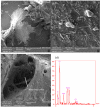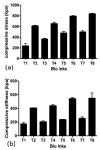An Experimental Study on the Mechanical and Biological Properties of Bio-Printed Alginate/Halloysite Nanotube/Methylcellulose/Russian Olive-Based Scaffolds
- PMID: 30607337
- PMCID: PMC6311641
- DOI: 10.15171/apb.2018.073
An Experimental Study on the Mechanical and Biological Properties of Bio-Printed Alginate/Halloysite Nanotube/Methylcellulose/Russian Olive-Based Scaffolds
Abstract
Purpose: Cartilage shows neither repairs nor regenerative properties after trauma or gradual wear and causes severe pain due to bones rubbing. Bioprinting of tissue-engineered artificial cartilage is one of the most fast-growing sciences in this area that can help millions of people against this disease. Methods: Bioprinting of proper bioscaffolds for cartilage repair was the main goal of this study. The bioprinting process was achieved by a novel composition consisting of alginate (AL), Halloysite nanotube (HNT), and methylcellulose (MC) prepared in bio-ink. Also, the effect of Russian olive (RO) in chondrocytes growth on bioscaffolds was also investigated in this work. Compressive, hardness and viscosity tests, Energy-Dispersive X-Ray Spectroscopy (EDX), Fourier-Transform Infrared Spectroscopy (FT-IR), Differential Scanning Calorimetry (DSC), water-soluble Tetrazolium (WST) assay, and also transmission electron microscopy (TEM) and scanning electron microscopy (SEM) were carried out. Results: The results show that in constant concentrations of AL, MC, and RO (20 mg/ml AL, 20 mg/ml MC, and 10 mg/ml RO) when concentration of HNT increased from 10 mg/ml (T-7) to 20 mg/ml (T-8) compressive stiffness increased from 241±45 kPa to 500.66±19.50 kPa. Also, 20 mg/ml of AL in composition saved proper water content for chondrocyte growth and produced good viscosity properties for a higher printing resolution. Conclusion: RO increased chondrocytes living cell efficiency by 11% on bioprinted scaffolds in comparison with the control group without RO. Results obtained through in-vivo studies were similar to those of in-vitro studies. According to the results, T-7 bio-ink has good potential in bioprinting of scaffolds in cartilage repairs.
Keywords: Alginate; Bio print; Halloysite Nanotube; Methylcellulose; Scaffold; WST assay.
Figures
Similar articles
-
3D printing of alginate/thymoquinone/halloysite nanotube bio-scaffolds for cartilage repairs: experimental and numerical study.Med Biol Eng Comput. 2022 Nov;60(11):3069-3080. doi: 10.1007/s11517-022-02654-5. Epub 2022 Sep 6. Med Biol Eng Comput. 2022. PMID: 36066743
-
Mechanical and biological performance of printed alginate/methylcellulose/halloysite nanotube/polyvinylidene fluoride bio-scaffolds.Mater Sci Eng C Mater Biol Appl. 2018 Nov 1;92:779-789. doi: 10.1016/j.msec.2018.07.035. Epub 2018 Jul 20. Mater Sci Eng C Mater Biol Appl. 2018. PMID: 30184807
-
3D Printed Chitosan Composite Scaffold for Chondrocytes Differentiation.Curr Med Imaging. 2021;17(7):832-842. doi: 10.2174/1573405616666201217112939. Curr Med Imaging. 2021. PMID: 33334294
-
Alginate based hydrogel inks for 3D bioprinting of engineered orthopedic tissues.Carbohydr Polym. 2022 Nov 15;296:119964. doi: 10.1016/j.carbpol.2022.119964. Epub 2022 Aug 5. Carbohydr Polym. 2022. PMID: 36088004 Review.
-
Extrusion 3D (Bio)Printing of Alginate-Gelatin-Based Composite Scaffolds for Skeletal Muscle Tissue Engineering.Materials (Basel). 2022 Nov 10;15(22):7945. doi: 10.3390/ma15227945. Materials (Basel). 2022. PMID: 36431432 Free PMC article. Review.
Cited by
-
Fabrication and characterization of microstructure-controllable COL-HA-PVA hydrogels for cartilage repair.J Mater Sci Mater Med. 2021 Aug 18;32(9):100. doi: 10.1007/s10856-021-06577-9. J Mater Sci Mater Med. 2021. PMID: 34406511 Free PMC article.
-
Tailorable Zinc-Substituted Mesoporous Bioactive Glass/Alginate-Methylcellulose Composite Bioinks.Materials (Basel). 2021 Mar 5;14(5):1225. doi: 10.3390/ma14051225. Materials (Basel). 2021. PMID: 33807758 Free PMC article.
-
3D printing of alginate/thymoquinone/halloysite nanotube bio-scaffolds for cartilage repairs: experimental and numerical study.Med Biol Eng Comput. 2022 Nov;60(11):3069-3080. doi: 10.1007/s11517-022-02654-5. Epub 2022 Sep 6. Med Biol Eng Comput. 2022. PMID: 36066743
-
Waste Autochthonous Tuscan Olive Leaves (Olea europaea var. Olivastra seggianese) as Antioxidant Source for Biomedicine.Int J Mol Sci. 2019 Nov 25;20(23):5918. doi: 10.3390/ijms20235918. Int J Mol Sci. 2019. PMID: 31775339 Free PMC article.
-
Challenges on optimization of 3D-printed bone scaffolds.Biomed Eng Online. 2020 Sep 3;19(1):69. doi: 10.1186/s12938-020-00810-2. Biomed Eng Online. 2020. PMID: 32883300 Free PMC article. Review.
References
-
- Savkovic V, Li H, Seon JK, Hacker M, Franz S, Simon JC. Mesenchymal stem cells in cartilage regeneration. Curr Stem Cell Res Ther. 2014;9(6):469–88. - PubMed
-
- Samiei M, Aghazadeh M, Alizadeh E, Aslaminabadi N, Davaran S, Shirazi S. et al. Osteogenic/odontogenic bioengineering with co-administration of simvastatin and hydroxyapatite on poly caprolactone based nanofibrous scaffold. Adv Pharm Bull. 2016;6(3):353. doi: 10.15171/apb.2016.047. - DOI - PMC - PubMed
LinkOut - more resources
Full Text Sources
Molecular Biology Databases
Research Materials













